Academy Award winner Eva Marie Saint will appear at the Laemmle Royal tonight for a Q&A and screening of “Exodus” (1960), directed by noir great Otto Preminger.
Film Noir File: Beautiful young Brando blazes in ‘Waterfront’
The Noir File is FNB’s guide to classic film noir, neo-noir and pre-noir from the schedule of Turner Classic Movies (TCM), which broadcasts them uncut and uninterrupted. The times are Eastern Standard and (Pacific Standard).
PICK OF THE WEEK
“On the Waterfront”
(1954, Elia Kazan). 8 p.m. (5 p.m.), Saturday, June 7.
Elia Kazan’s socially conscious film noir masterpiece “On the Waterfront” is a touchstone of the American cinema, one of those movies you never forget. This powerhouse social drama, a film loaded with heart, brains and guts, pulls you into the crime-ravaged docks of New York City in the 1950s.
Shot in New Jersey and based on actual events, adapted by writer Budd Schulberg from a series of articles by Malcolm Johnson, the movie portrays an exploited band of longshoremen battling for their rights on a dock run by a corrupt union, gangsters and killers. Kazan, Schulberg and a wonderful ensemble give this story a stinging realism few other films of the ’50s can match.
In “Waterfront,” we get a ringside seat at a battle between good and evil, crime and the law. Pitted against the brutal, crooked union-boss, Johnny Friendly (Lee J. Cobb), is an idealistic, courageous priest, Father Barry (Karl Malden), and a washed-up, but eventually heroic ex-boxer, Terry Malloy (Marlon Brando).
Among the movie’s other indelible characters: Rod Steiger as Charlie, Terry Malloy’s fancy-dressing mouthpiece-for-the-mob brother, and Eva Marie Saint, in her Oscar-winning movie debut as Edie Doyle, whose brother was murdered by Johnny Friendly’s thugs, and with whom Terry falls in love.
“On the Waterfront” is a knockout on all levels. It has great direction (Kazan), a great tough script (Schulberg), great black-and-white photography (Boris Kaufman), great naturalistic art direction (Richard Day), a great score (Leonard Bernstein), and, most of all, that perfect ensemble cast, with the extraordinary Brando at his youthful peak.
Brando makes every one of his scenes come alive, breathe and bleed, especially when Terry cries out to his brother Charlie (Steiger): “You don’t understand! I coulda had class! I coulda been a contender! I coulda been somebody! Instead of a bum, which is what I am.”
We’ll always remember that electrifying confession of failure and pain in the back of that cab, coming from the young brilliant actor playing the gentle-hearted, beaten-down ex-pug. He moves us so deeply because he was more than a contender; he was the champ. He had more than class; he had genius. He was more than somebody. He was Brando.
You can watch “On the Waterfront” on TCM of course. But if you’re lucky enough to be in Los Angeles this weekend, you can see the film on the big screen at 7:30 p.m., Friday, June 6, at the Los Angeles County Museum of Art. Appearing on stage at that showing, to discuss the movie, will be one of its eight Oscar-winners, Eva Marie Saint.
Thursday, June 5
10 p.m. (7 p.m.): “The Tarnished Angels” (1957, Douglas Sirk).
The setting: New Orleans at Mardi Gras. The source: William Faulkner’s novel “Pylon.” Scripted by George Zuckerman, who also penned Sirk’s “Written on the Wind” (1956).
The stars (who also played in “Wind”): Robert Stack and Dorothy Malone are a married couple; Rock Hudson is Burke Devlin, a drunken newspaper reporter at the Times-Picayune, who becomes enamored of them both.
With compassion and high style, “Tarnished Angels” focuses on life’s fringes and the ironies of heroism. Brilliantly shot by Irving Glassberg (who also shot Sirk’s “Captain Lightfoot”), it’s one of the best-looking black-and-white/widescreen movies of its era, a dark gem of noir style.
The one flaw is Hudson’s mostly un-drunk Devlin. But it’s not his fault; Hudson began the movie playing Devlin as soused, but Universal, fearful of harm to their big star’s image, ordered him to play it sober.
The film is a classic anyway. It was Sirk’s favorite of the films he directed and Faulkner preferred it to all the other movies made from his work, even the acknowledged 1949 classic “Intruder in the Dust.” Faulkner, no stranger to booze himself, even liked Hudson’s cold-sober Devlin.
Saturday, June 7
8 p.m. (5 p.m.): “On the Waterfront” (1954, Elia Kazan). See Pick of the Week.
10 p.m. (7 p.m.): “Rumble on the Docks” (1956, Fred F. Sears). A poor man’s mash-up of “On the Waterfront” and “Crime in the Streets,“ with rebel rocker James Darren (“Gidget”), Laurie Carroll and Robert Blake.
11:30 p.m. (8:30 p.m.): “The Mob” (1951, Robert Parrish). Broderick Crawford is an undercover cop, playing a bad guy to infiltrate a poisonous waterfront mob. The Mob includes Richard Kiley, Ernest Borgnine, Charles Bronson and Neville Brand. Lesser known, but a good noir.
Sunday, June 8
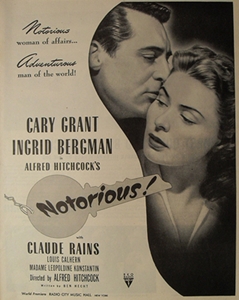 6 p.m. (3 p.m.): “Notorious” (1946, Alfred Hitchcock). With Cary Grant, Ingrid Bergman, Claude Rains and Louis Calhern. Reviewed in FNB on Feb. 12, 2013 and Feb. 20, 2012.
6 p.m. (3 p.m.): “Notorious” (1946, Alfred Hitchcock). With Cary Grant, Ingrid Bergman, Claude Rains and Louis Calhern. Reviewed in FNB on Feb. 12, 2013 and Feb. 20, 2012.
Tuesday June 10
8 p.m. (5 p.m.): “The Woman in the Window” (1944, Fritz Lang). With Edward G. Robinson, Joan Bennett, Raymond Massey and Dan Duryea. Reviewed in FNB on Nov. 24, 2011.
10 p.m. (7. P.m.): “Scarlet Street” (1945, Fritz Lang). With Edward G. Robinson, Joan Bennett and Dan Duryea. Reviewed in FNB on Nov. 24, 2011.
Eva Marie Saint to appear at 60th anniversary screening of ‘On the Waterfront’
Think of “On the Waterfront” (1954, Elia Kazan) and, most times, Marlon Brando springs to mind, with his famous line: “I coulda been a contender.”
But don’t forget that behind the great Brando was a great blonde: Eva Marie Saint, who won the Best Supporting Actress Oscar for her work. Her award was one eight wins for the film: Picture, Director, Editing, Actor, Writing (Story and Screenplay), B&W Art Direction/Set Decoration, B&W Cinematography.
With its expressionistic black and white visuals, and its story of crime in the lower depths of New York City, “On the Waterfront” more than qualifies as film noir.
On Friday, June 6, the Academy and the Los Angeles County Museum of Art (Lacma) is presenting a special screening in honor of the film’s 60th birthday at the museum’s Bing Theater. Eva Marie Saint will make an appearance. We at FNB are looking forward to hearing about her memories of making the flick.
Film noir flourishes at TCM film festival in Hollywood
From Marie Windsor’s character in “The Killing” telling her wounded husband (played by Elisha Cook, Jr.) to cab to the hospital because she doesn’t feel like calling an ambulance to Grace Kelly fending off her attacker and foiling the eponymous plot in “Dial M for Murder,” on-screen femmes fatales claimed their power at the TCM Classic Film Festival April 25-28 in Hollywood.
The film noir slate was particularly rich as was the experience of seeing these film on the big screen – the lighting, the compositions, the close-ups all popped in a way that just doesn’t happen when you watch these titles on TV. Additionally, the festival does a splendid job of finding guests to introduce the films.
At Thursday’s screening of “The Killing,” actress Coleen Gray shared memories of working with director Stanley Kubrick on what would turn out to be his break-though movie. “I knew he was good,” she said. “The cast is wonderful. The story, the director and the actors are in tune. And look at the cutting – it was cut to create a masterpiece. You go and see it and you bow to Mr. Kubrick.” She added that Kubrick spent much of his directorial energy working with Marie Windsor on her hard-as-nails dame Sherry Peatty.
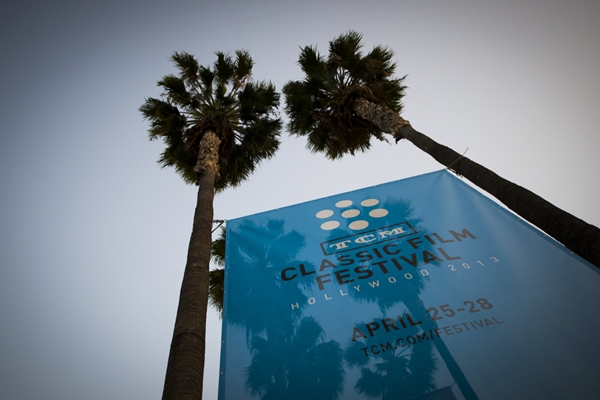
There was film noir aplenty at the TCM festival as well as special guests, panels, a poolside screening and parties. Photo by Edward M. Pio Roda
Fans of Ms. Windsor’s got another chance to connect with her at Friday’s screening of “The Narrow Margin.” The special guest was actress Jacqueline White. Also during that time slot producer Stanley Rubin reminisced about Marilyn Monroe, Robert Mitchum and Otto Preminger before a showing of 1954’s “River of No Return,” a stunning example of CinemaScope’s capabilities.
“[Marilyn] and Otto didn’t like each other and so we became very friendly. She was a perfect lady,” he said, adding that she was friendly and professional with Mitchum as well.
Watching Monroe and Mitchum, at the height of their physical radiance in this picture, ignited in me a newfound passion for Westerns. (Believe me, this is quite a feat.)
It’s always a toss-up when deciding between a beloved classic and a little-screened rarity. We at FNB decided to mix it up a little and forgo “Notorious,” which I often liken to a glass of Veuve Clicquot, for the chance to see a 1956 Jean Gabin black comedy “La Traversée de Paris.” Gabin is always good, but the film is uneven, without much tension or humor, a bit like a flabby claret.
A much better rare treat was the definitive British film noir “It Always Rains on Sunday,” (1947, Robert Hamer), set in London’s East End, featuring a Jewish family and starring John McCallum as prison escapee Tommy Swann and tough yet oddly dainty Googie Withers as his ex-gf. The Film Noir Foundation’s Eddie Muller introduced the film, noting that it was less a crime flick than an effective portrayal of the plight of the poor and downtrodden.
We watched this with our friend Debra Levine of artsmeme.com. Our verdict: It’s a good, engaging film but what makes it great is the sleek, striking cinematography. “Tommy made some poor choices,” Ms. Levine overheard someone saying as we left the theater. Aah, but we all know that “choice” is but a futile joke in the world of film noir!
Another Friday highlight: the lovely and gracious Eva Marie Saint discussing “On the Waterfront.”
The next morning, early birds were rewarded with a talk by Polly Bergen at the screening of “Cape Fear,” one of Robert Mitchum’s most menacing roles. Later-risers could head to the Egyptian Theatre for the West Coast restoration premiere of 1929’s “The Donovan Affair” with live actors (from Bruce Goldstein and company) and sound effects to recreate the lost soundtrack.
Next up was a film noir must-see: “They Live by Night” (1949, Nicholas Ray), the quintessential young-lovers-on-the-run story, with an appearance by his widow Susan Ray and introduction by Eddie Muller. Commenting on Ray’s exploratory directing style, she said: “He did not go in with a preconceived idea of what should happen in a scene. He would set it up, light a fuse and watch. He would prod or provoke if necessary. He didn’t impose truth, he looked for it.”
And on Ray’s interest in telling the stories of young people, often loners or societal outcasts, she noted: “He saw the juice, potential, openness and flexibility of youth and he loved it.” Nick Ray’s gift as a visual poet is never more apparent than when you see “They Live by Night” on the big screen.
Continuing the noir mood was “Tall Target” (1951, Anthony Mann), a period noir, starring Dick Powell, Paula Raymond and Ruby Dee, based on an actual plot to assassinate Abraham Lincoln before he could take the oath office in 1861. Film historian Donald Bogle gave an insightful introduction.
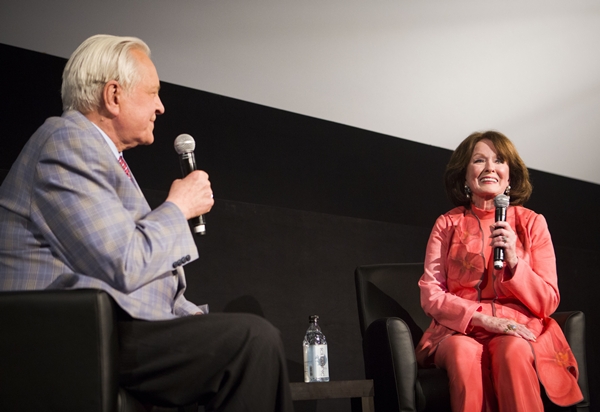
Bob Osborne chats with Ann Blyth before Saturday night’s screening of “Mildred Pierce.” Photo by John Nowak
Then it was back to the Egyptian, where the line for “Mildred Pierce,” snaked down a busy side street of Hollywood Boulevard. Special guest actress Ann Blyth said of Joan Crawford, the film’s mega-star: “I have nothing but wonderful memories of her. She was kind to me during the making of the movie and she was kind to me for many years after.”
Popcorn, Coke, Raisinets and watching Crawford pull out all the shoulder-padded stops – what more could a noirista wish for?
Sunday morning kicked off with a choice between “Badlands,” “Gilda,” or sleeping in a bit and we hit snooze. Sorry. They don’t call me Lazy Legs for nothing. Our first movie was 1973’s “Scarecrow,” starring Al Pacino and Gene Hackman – it was one of the best and most resonant films we’ve seen in a long time. The acting is tremendous in this great-looking film, which won the Palme d’Or at Cannes. Director Jerry Schatzberg discussed his work in a pre-film chat with Leonard Maltin.
Afterward, we managed to catch the very noirish “Safe in Hell” (1931, William Wellman), starring Dorothy Mackaill as a streetwise blonde who holds her own among a slew of unsavory men while she’s hiding out in the Caribbean. Donald Bogle introduced the movie and William Wellman, Jr. answered questions afterward.
A great way to wrap up the fest, before heading to the after-party at the Roosevelt Hotel, was a 3-D presentation of “Dial M for Murder.” Leonard Maltin and the always-entertaining actor-producer-director Norman Lloyd, 98, discussed 3-D and the working methods of Alfred Hitchcock. This Hitchcock gem, a perfect example of his subversive casting, is often underrated so we particularly enjoyed seeing it; we noticed that just about every seat was taken.
Hats off to TCM for another superb film festival! The staff does an excellent job running every aspect of this event and it is much appreciated.
The Noir File: Six gems by the all-time master of suspense
By Michael Wilmington and Film Noir Blonde
The Noir File is FNB’s weekly guide to classic film noir, neo-noir and pre-noir on cable TV. All the movies below are from the current schedule of Turner Classic Movies (TCM), which broadcasts them uncut and uninterrupted. The times are Eastern Standard and (Pacific Standard).
PICK OF THE WEEK
Six by Alfred Hitchcock (1941-59) Friday, Nov. 23, 6:30 a.m. – 6 p.m. (3:30 a.m.- 3 p.m.)
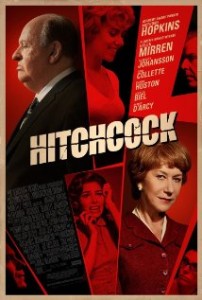 Hitchcock was the movies’ all-time master of suspense – the supreme chronicler of wrong men on the run and notorious ladies in distress, of psychos and vertigo, of scenic spy chases and excruciating murder scenes, of shadows and strangers and suspicion, and most of all, of expert suspense movies, pulse-pounding pictures that got you on the hook fast, and kept you there until the last minute.
Hitchcock was the movies’ all-time master of suspense – the supreme chronicler of wrong men on the run and notorious ladies in distress, of psychos and vertigo, of scenic spy chases and excruciating murder scenes, of shadows and strangers and suspicion, and most of all, of expert suspense movies, pulse-pounding pictures that got you on the hook fast, and kept you there until the last minute.
He was also the master of film noir, as this six film mini-marathon of movies proves. Dating from the heyday of both Hitchcock and classic noir (1941 to 1959), they’re films that you may have seen before, but that are always welcome for a fresh viewing. Hitchcock was one of the most punctilious, painstaking and brilliantly inventive of all major movie artists and that’s why you can see these pictures over and over. While you’re in the mood, you’ll probably also want to catch the opening of the new movie “Hitchcock,” Sacha Gervasi’s bio-thriller about the making of “Psycho,” with Anthony Hopkins as the master of suspense himself.
Friday, Nov. 23, 6:30 a.m. (3:30 a.m.): “The Dick Cavett Show” (1972). Cavett interviews Hitch, for the release of “Frenzy.”
8 a.m. (5 a.m.): “Under Capricorn” (1949). In this somewhat stiff Australian-set period romance, Ingrid Bergman plays a reclusive alcoholic torn between bad-tempered husband Joseph Cotten and charming visitor Michael Wilding – with Margaret Leighton a scene-stealer as the obsessive housekeeper. One of the director’s rare commercial flops, “Under Capricorn” is still notable for its complex, long-take moving camera scenes (like the ones in “Rope”).
10 a.m. (7 a.m.): “Strangers on a Train” (1951).
11:45 a.m. (8:45 a.m.) “The Wrong Man” (1956). Hitchcock takes a real-life episode –the arrest and conviction of New York musician Manny Balestrero (Henry Fonda) for a robbery he didn’t commit – and squeezes out as much suspense as he does from his fictional thrillers. Co-scripted by playwright Maxwell Anderson; with Vera Miles and Harold J. Stone.
1:45 a.m. (10:45 a.m.): “North by Northwest” (1959). One of Hitchcock’s two great spy-chase thrillers (the other is “The 39 Steps”), “North by Northwest” follows a suave but beleaguered Manhattan advertising executive (Cary Grant), who’s mistaken for a spy who doesn’t exist, charged with a murder he didn’t commit, pursued by bad guys (James Mason, Martin Landau) whose machinations bewilder him. Oh and he’s involved with a blonde beauty (Eva Marie Saint) who may want him dead. And then there’s that pesky crop-dusting plane “dustin’ where there ain’t no crops.” One of the best, most typical and most beautifully made Hitchcocks. Ingeniously scripted by Ernest Lehman.
4:15 p.m. (1:15 p.m.): “Suspicion” (1941).
6 p.m. (3 p.m.): “Dial M for Murder” (1954).
Sunday, Nov. 18
2 p.m. (11 a.m.): “Casablanca” (1942, Michael Curtiz).
4 p.m. (1 p.m.): “Bonjour Tristesse” (1957, Otto Preminger). Smooth as silk and cool as champagne, Preminger’s adaptation of the young French writer Françoise Sagan’s cynical novel, focuses on a brainy young belle (Jean Seberg), whose intense relationship with her playboy father (David Niven) is disrupted by his perceptive fiancée (Deborah Kerr) – a clash that leads to darker currents and conflicts. Seberg’s chilly performance here inspired her role several years later in Jean-Luc Godard’s “Breathless.”
Guest programmer Spike Lee picks four great titles for TCM
Director, producer, writer and actor Spike Lee, guest programming for TCM, has selected four excellent films, all of which have strong film-noir elements and social/political themes. The movies will play at various times this month, starting on Thursday, July 5.
“Ace in the Hole” (1951, Billy Wilder) Kirk Douglas stars as a sleazy reporter who will go to any length to restart his career.
“On the Waterfront” (1954, Elia Kazan) A washed-up boxer and mob member (Marlon Brando) tries to redeem himself when he falls in love with a victim of the mob (Eva Marie Saint).
“A Face in the Crowd” (1957, Elia Kazan) The unlikely rise of a brutal drifter (Andy Griffith) to a media/TV sensation is set against the background of the South in the 1950s. Also stars Patricia Neal and Walter Matthau.
“The Night of the Hunter” (1955, Charles Laughton) Another Southern saga: Robert Mitchum plays a murderous preacher, specializing in seducing and killing widows. The outstanding cast includes Shelley Winters and Lillian Gish.
Read Michael Wilmington’s tribute to Andy Griffith here.
Meanwhile, a very happy Fourth of July to everyone!





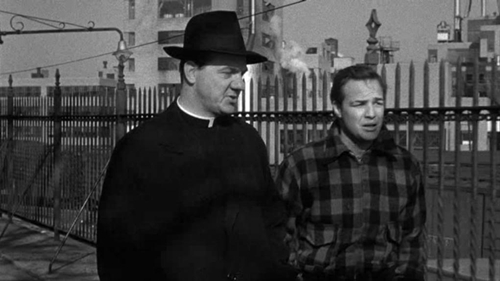
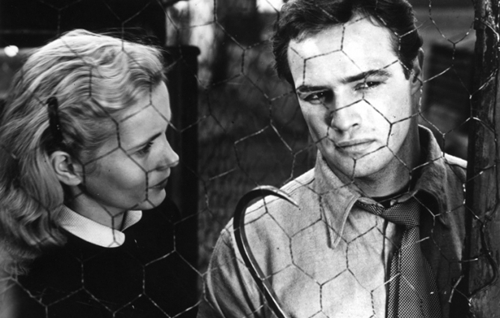
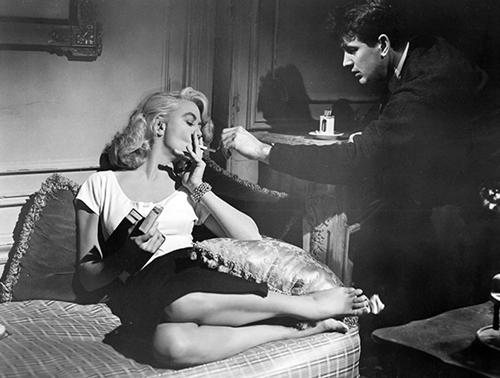
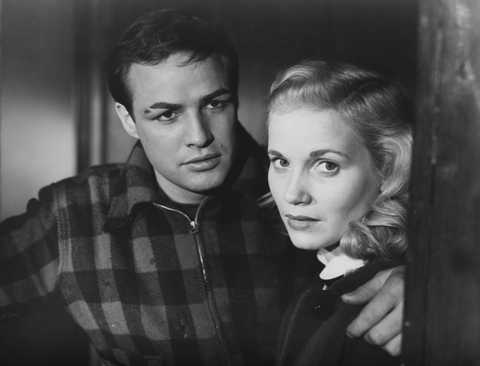
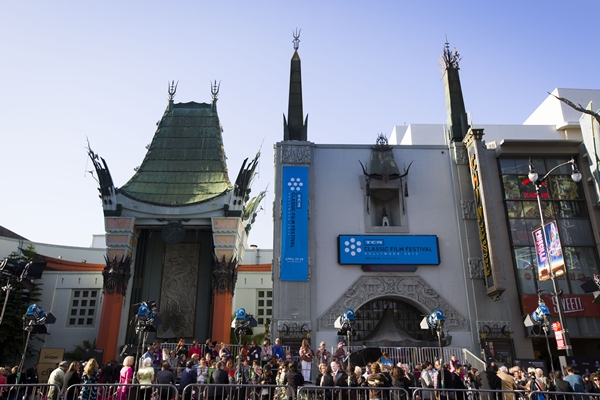

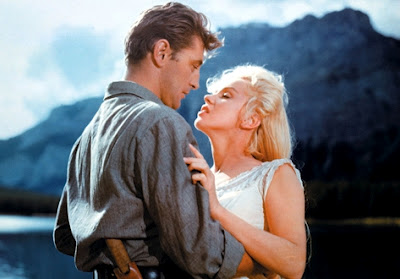

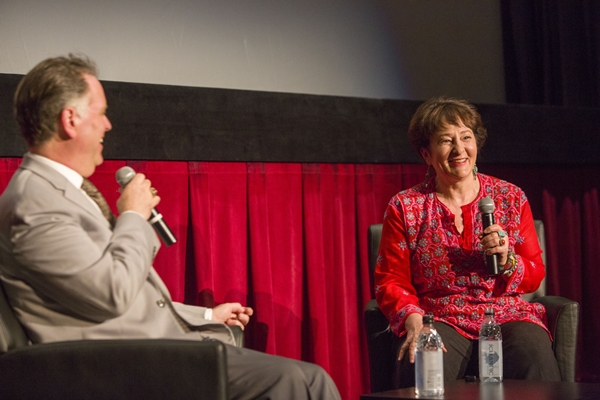
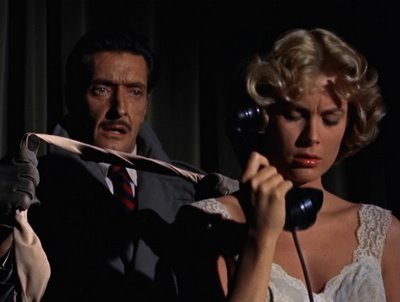
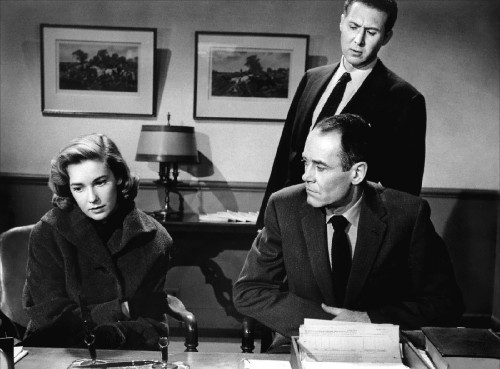
![Bonjour Tristesse DVD[1]](http://www.filmnoirblonde.com/wp-content/uploads/2012/11/Bonjour-Tristesse-DVD11.jpg)
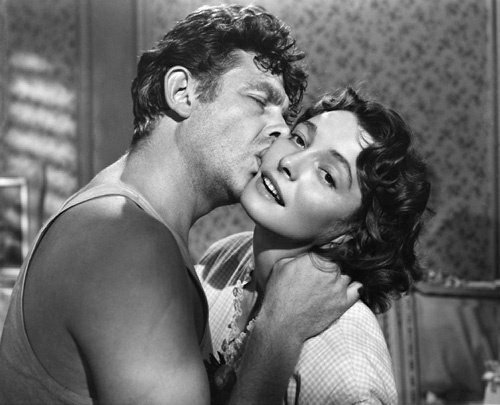





From FNB readers